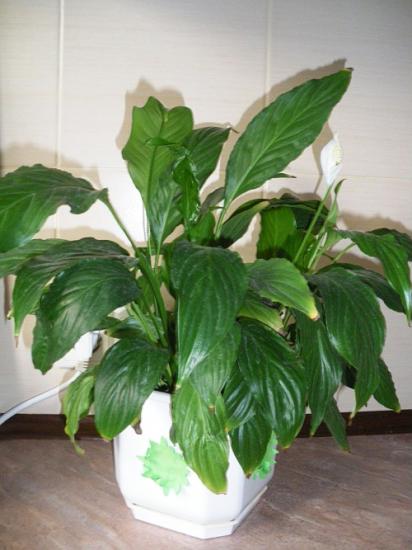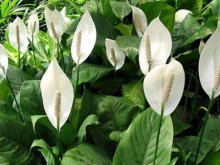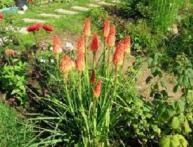How to properly replant and care for spathiphyllum

The most favorite and common flower among indoor plant lovers is spathiphyllum.
Thanks to its magnificent white flowers, spathiphyllum will decorate any room, like an apartment or office. This perennial plant does not require special care and conditions. for growing.
Content:
Spathiphyllum transplant: features
Spathiphyllum is an ornamental evergreen plant of the Araceae family. The plant can reach up to 1 meter in height. It has no stem.

Spathiphyllum leaves are whole and have an oval or lanceolate shape. The shade is dark green or light green, sometimes with yellowish-white streaks.
The inflorescence of the plant is a yellowish-white spadix, which is located on a long stalk. It covers a modified leaf. Many people mistake it for a flower.
There are different types and varieties of spathiphyllum, which differ in the size and color of the cob. The most common varieties of spathiphyllum:
- Spathiphyllum spoon-shaped
- Abundantly flowering spathiphyllum
- Spathiphyllum Wallis
- Cannoleaf spathiphyllum
- Spathiphyllum charming
After purchasing spathiphyllum, transplantation should be carried out after 2-3 weeks. It is advisable to replant an ornamental plant once a year, and it is better to do this in March or April.
The flower gradually grows, and the roots begin to fill the entire pot.The plant becomes cramped, so transplantation is carried out into a larger pot.
The pot is selected taking into account the degree of growth of spathiphyllum. Every year, the container should be a few centimeters larger in diameter. This only applies to young plants.
For an adult spathiphyllum, the soil should be updated once every 2 years. You can replant while the plant is flowering, but if possible, postpone this procedure, as it will take a long time to adapt.
Video about planting, care and propagation of spathiphyllum:
Before replanting, the soil should be prepared. Good growth and the possibility of flowering of spathiphyllum depend only on high-quality and correct plant transplantation.
You can purchase a soil mixture for the plant at a special flower shop or prepare it yourself to transfer was a success. The soil should be loose, slightly acidic and fertile, therefore it should consist of deciduous soil, peat, humus and sand in a ratio of 2:1:1:1. The pot for the plant must be spacious.
Spathiphyllum has rather fragile roots, so replanting must be done carefully so as not to damage them. Using a garden scoop, separate the soil and plant roots from the walls of the pot.
This can sometimes be difficult to do, so the soil can be slightly moistened first. Next, shake off the soil from the roots and carefully examine the plant for the presence of putrefactive diseases.
If some roots are damaged, then they must be removed and the cut areas treated with activated carbon. It must be crushed first.
First place a drainage layer in the prepared pot.As a drainage layer, you can use large pebbles, expanded clay or brick fragments.
After this, place the flower in the pot and fill it with soil. It is important to ensure that the root system is completely covered with soil. Next, lightly compact the soil, water the plant and spray the leaves.
Spathiphyllum care requirements
Spathiphyllum is a light-loving plant, so it must be placed in well-lit places. Lighting plays a very important role for him.

It is advisable to avoid contact direct sunlight. The optimal temperature for the plant is 16-17 degrees. When the temperature drops, the growth of spathiphyllum stops.
In spring and summer, the plant can even withstand high temperatures of up to 27 degrees.
In hot weather, the flower must be watered abundantly, but it is important to ensure that the soil dries out. If you water too much, dark spots may appear on the leaves, and if there is a lack of moisture, they will become drooping.
Overmoistening and drafts should be avoided. In the autumn-winter period, watering spathiphyllum should be reduced. Before as water The plant water must be left to settle for several days.
Spathiphyllum loves high humidity. Spraying with soft water and a warm shower have a beneficial effect on plant growth.
You can also fill a tray with water, add pebbles, damp moss or sand and place the pot on it.
During the flowering period, the plant should be sprayed carefully so that water does not get on the cob.
The active growing season of the spathiphyllum plant begins in March and ends in September. During this period it is recommended to feed the plant with a special fertilizer intended specifically for spathiphyllum.
Sometimes they alternate between mineral and organic fertilizers. Before and after applying fertilizer, spathiphyllum must be well watered. It is necessary to feed the flower 2 times a month.
If you follow all the rules of agricultural technology, you can easily transplant spathiphyllum. The transplant should be performed very carefully and carefully. If all requirements are met, spathiphyllum will bloom in 6-8 months.
Interesting information about the vegetable garden











Comments
Spathiphyllum is also called Women's happiness. In my opinion, a very capricious plant! I just can’t please him... either the leaves dry out or become covered with spots, I’ve already removed all the diseased ones, transplanted them into a new pot... it still doesn’t bloom! And I really want happiness!